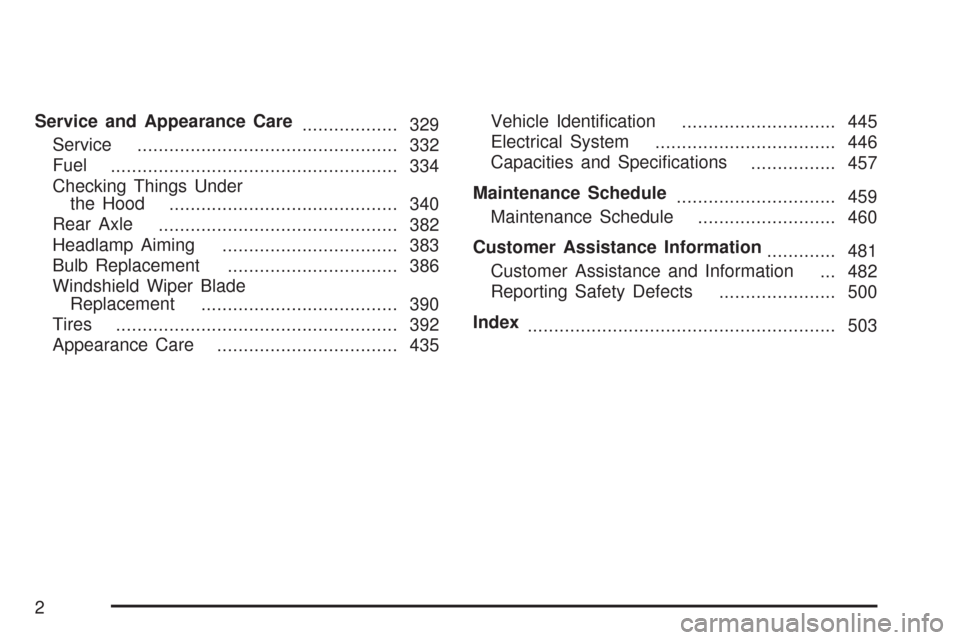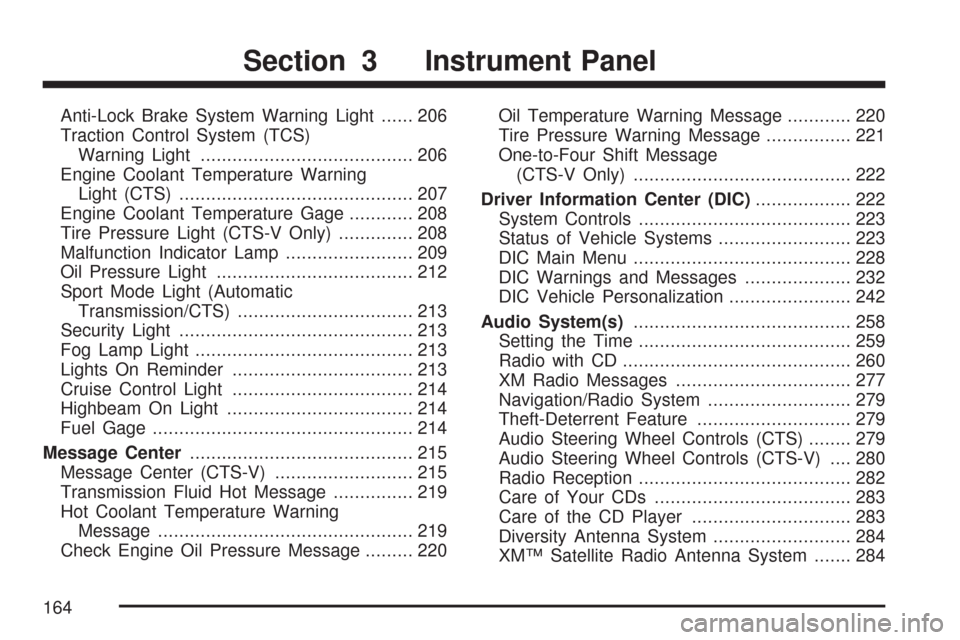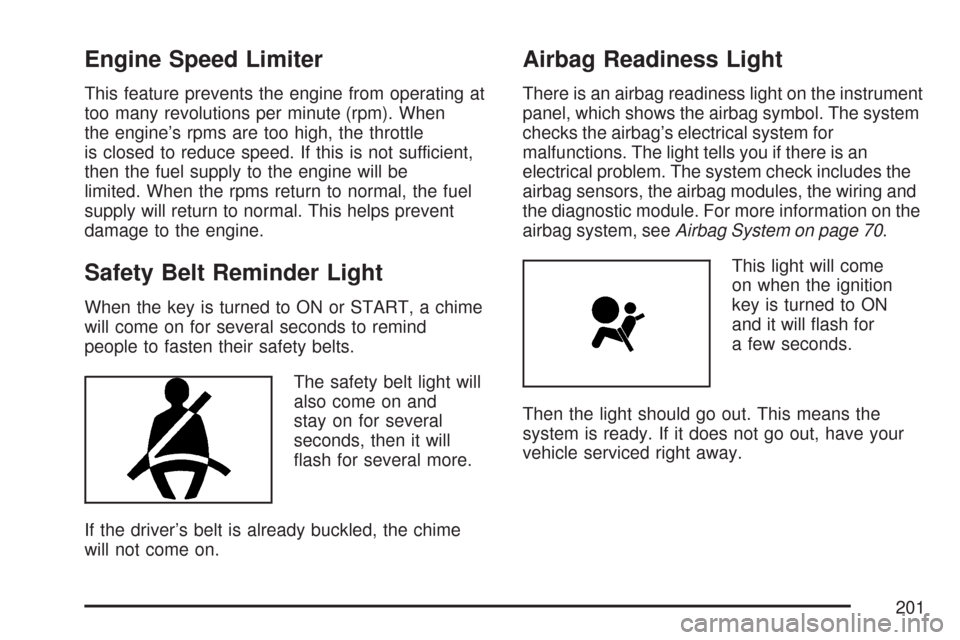fuel CADILLAC CTS V 2007 1.G Owners Manual
[x] Cancel search | Manufacturer: CADILLAC, Model Year: 2007, Model line: CTS V, Model: CADILLAC CTS V 2007 1.GPages: 518, PDF Size: 2.77 MB
Page 2 of 518

Service and Appearance Care
.................. 329
Service
................................................. 332
Fuel
...................................................... 334
Checking Things Under
the Hood
........................................... 340
Rear Axle
............................................. 382
Headlamp Aiming
................................. 383
Bulb Replacement
................................ 386
Windshield Wiper Blade
Replacement
..................................... 390
Tires
..................................................... 392
Appearance Care
.................................. 435Vehicle Identi�cation
............................. 445
Electrical System
.................................. 446
Capacities and Speci�cations
................ 457
Maintenance Schedule
.............................. 459
Maintenance Schedule
.......................... 460
Customer Assistance Information
............. 481
Customer Assistance and Information
... 482
Reporting Safety Defects
...................... 500
Index
.......................................................... 503
2
Page 120 of 518

To prevent starter-motor gear damage, this
system also prevents cranking if the engine is
already running. The engine cranking can
be stopped by turning the ignition switch to the
ACCESSORY or OFF position.
2. If your engine will not start, or starts but then
stops, it could be �ooded with too much
gasoline. Try pushing your accelerator pedal
all the way to the �oor and holding it there
as you turn the key to START. If the vehicle
starts brie�y but then stops again, do the
same thing.
Notice:Your engine is designed to work with
the electronics in your vehicle. If you add
electrical parts or accessories, you could
change the way the engine operates. Before
adding electrical equipment, check with
your dealer. If you do not, your engine might
not perform properly. Any resulting damage
would not be covered by your vehicle’s
warranty.Engine Coolant Heater
Your vehicle may have an engine coolant heater.
In very cold weather, 0°F (−18°C) or colder,
the engine coolant heater can help. You will get
easier starting and better fuel economy during
engine warm-up.
Usually, the coolant heater should be plugged in
a minimum of four hours prior to starting your
vehicle. At temperatures above 32°F (0°C), use of
the coolant heater is not required. Your vehicle
may also have an internal thermostat in the
plug end of the cord. This will prevent operation of
the engine coolant heater when the temperature
is at or above 0°F (−18°C) as noted on the cord.
120
Page 124 of 518

DRIVE (D):This position is for normal driving.
It provides the best fuel economy for your vehicle.
If you need more power for passing, and you are:
Going less than 35 mph (55 km/h), push the
accelerator pedal about halfway down.
Going about 35 mph (55 km/h) or more,
push the accelerator all the way down.
The transmission will shift down to a lower gear
and have more power.
Downshifting the transmission in slippery road
conditions could result in skidding, see Skidding
underLoss of Control on page 303
Notice:Spinning the tires or holding the
vehicle in one place on a hill using only
the accelerator pedal may damage the
transmission. If you are stuck, do not spin
the tires. When stopping on a hill, use
the brakes to hold the vehicle in place.
Driver Shift Control (DSC)
Notice:If you drive your vehicle at high RPMs
without upshifting while using Driver Shift
Control (DSC), you could damage your
vehicle. Always upshift when necessary while
using DSC.
Your automatic transmission has a Driver Shift
Control (DSC) feature that allows you to change
gears similar to a manual transmission. To use the
DSC feature:
1. Slide the shift lever over from DRIVE (D) to
the right into the DSC area.
The sport mode light in
the instrument panel
cluster will come on.
If you do not move the shift lever forward or
rearward, the vehicle will be in sport mode.
When you are in the sport mode the
vehicle will still shift automatically.
124
Page 128 of 518

Skip Shift (CTS-V)
1r4:This message may appear in the message
center in the speedometer during light throttle, low
speed maneuvers (15 to 19 mph (24 to 31 km/h)).
When this message appears, you can only shift
from FIRST (1) to FOURTH (4) instead of
FIRST (1) to SECOND (2).
SeeOne-to-Four Shift Message (CTS-V Only) on
page 222for more information.
During the shift from FIRST (1) to FOURTH (4),
pull the shift lever straight back using light force on
the shift lever. You must complete the shift into
FOURTH (4) to turn off this feature. This helps get
the best possible fuel economy. The skip shift
feature is turned backed on when the vehicle is at
a complete stop and the digital speedometer
reads 0 mph (0 km/h).
Notice:Forcing the shift lever into any gear
except FOURTH (4), when the One – to – Four
Shift message comes on, may damage the
transmission. Shift only from FIRST (1) to
FOURTH (4) when the One – to – Four Shift
message comes on.The One – to – Four Shift message comes on when:The engine coolant temperature is higher than
169°F (76°C) and you are going 15 to 19 mph
(24 to 31 km/h).
You are pressing the accelerator pedal less
then a quarter of the way down.
Parking Brake
The parking brake pedal
is located on the lower
portion of the instrument
panel to the left of the
steering wheel.
To set the parking brake, hold the regular brake
pedal down with your right foot and push the
parking brake pedal down with your left foot.
128
Page 164 of 518

Anti-Lock Brake System Warning Light...... 206
Traction Control System (TCS)
Warning Light........................................ 206
Engine Coolant Temperature Warning
Light (CTS)............................................ 207
Engine Coolant Temperature Gage............ 208
Tire Pressure Light (CTS-V Only).............. 208
Malfunction Indicator Lamp........................ 209
Oil Pressure Light..................................... 212
Sport Mode Light (Automatic
Transmission/CTS)................................. 213
Security Light............................................ 213
Fog Lamp Light......................................... 213
Lights On Reminder.................................. 213
Cruise Control Light.................................. 214
Highbeam On Light................................... 214
Fuel Gage................................................. 214
Message Center.......................................... 215
Message Center (CTS-V).......................... 215
Transmission Fluid Hot Message............... 219
Hot Coolant Temperature Warning
Message................................................ 219
Check Engine Oil Pressure Message......... 220Oil Temperature Warning Message............ 220
Tire Pressure Warning Message................ 221
One-to-Four Shift Message
(CTS-V Only)......................................... 222
Driver Information Center (DIC).................. 222
System Controls........................................ 223
Status of Vehicle Systems......................... 223
DIC Main Menu......................................... 228
DIC Warnings and Messages.................... 232
DIC Vehicle Personalization....................... 242
Audio System(s)......................................... 258
Setting the Time........................................ 259
Radio with CD........................................... 260
XM Radio Messages................................. 277
Navigation/Radio System........................... 279
Theft-Deterrent Feature............................. 279
Audio Steering Wheel Controls (CTS)........ 279
Audio Steering Wheel Controls (CTS-V).... 280
Radio Reception........................................ 282
Care of Your CDs..................................... 283
Care of the CD Player.............................. 283
Diversity Antenna System.......................... 284
XM™ Satellite Radio Antenna System....... 284
Section 3 Instrument Panel
164
Page 198 of 518

Instrument Panel Cluster
The instrument panel cluster is designed to let you know at a glance how your vehicle is running. You will
know how fast you are going, how much fuel you are using and many of the other things you will need
to know to drive safely and economically.
CTS (United States version shown, Canada similar)
198
Page 201 of 518

Engine Speed Limiter
This feature prevents the engine from operating at
too many revolutions per minute (rpm). When
the engine’s rpms are too high, the throttle
is closed to reduce speed. If this is not sufficient,
then the fuel supply to the engine will be
limited. When the rpms return to normal, the fuel
supply will return to normal. This helps prevent
damage to the engine.
Safety Belt Reminder Light
When the key is turned to ON or START, a chime
will come on for several seconds to remind
people to fasten their safety belts.
The safety belt light will
also come on and
stay on for several
seconds, then it will
�ash for several more.
If the driver’s belt is already buckled, the chime
will not come on.
Airbag Readiness Light
There is an airbag readiness light on the instrument
panel, which shows the airbag symbol. The system
checks the airbag’s electrical system for
malfunctions. The light tells you if there is an
electrical problem. The system check includes the
airbag sensors, the airbag modules, the wiring and
the diagnostic module. For more information on the
airbag system, seeAirbag System on page 70.
This light will come
on when the ignition
key is turned to ON
and it will �ash for
a few seconds.
Then the light should go out. This means the
system is ready. If it does not go out, have your
vehicle serviced right away.
201
Page 209 of 518

Malfunction Indicator Lamp
Check Engine Light
Your vehicle has a
computer which
monitors operation of
the fuel, ignition,
and emission control
systems.
This system is called OBD II (On-Board
Diagnostics-Second Generation) and is intended
to assure that emissions are at acceptable
levels for the life of the vehicle, helping to produce
a cleaner environment. The check engine light
comes on to indicate that there is a problem and
service is required. Malfunctions often will be
indicated by the system before any problem is
apparent. This may prevent more serious damage
to your vehicle. This system is also designed to
assist your service technician in correctly
diagnosing any malfunction.Notice:If you keep driving your vehicle with
this light on, after awhile, the emission controls
might not work as well, your vehicle’s fuel
economy might not be as good, and the engine
might not run as smoothly. This could lead
to costly repairs that might not be covered by
your warranty.
Notice:Modi�cations made to the engine,
transmission, exhaust, intake, or fuel system
of your vehicle or the replacement of the
original tires with other than those of the same
Tire Performance Criteria (TPC) can affect
your vehicle’s emission controls and can cause
this light to come on. Modi�cations to these
systems could lead to costly repairs not
covered by your warranty. This could also
result in a failure to pass a required Emission
Inspection/Maintenance test. SeeAccessories
and Modifications on page 332.
209
Page 210 of 518

This light should come on, as a check to show
you it is working, when the ignition is on and the
engine is not running. If the light does not
come on, have it repaired. This light will also
come on during a malfunction in one of two ways:
Light Flashing— A mis�re condition has
been detected. A mis�re increases vehicle
emissions and may damage the emission
control system on your vehicle. Diagnosis and
service may be required.
Light On Steady— An emission control
system malfunction has been detected on your
vehicle. Diagnosis and service may be
required.
If the Light is Flashing
The following may prevent more serious damage
to your vehicle:
Reducing vehicle speed
Avoiding hard accelerations
Avoiding steep uphill grades
If you are towing a trailer, reduce the amount
of cargo being hauled as soon as it is
possibleIf the light stops �ashing and remains on steady,
see “If the Light Is On Steady” following.
If the light continues to �ash, when it is safe to do
so, stop the vehicle. Find a safe place to park
your vehicle. Turn the key off, wait at least
10 seconds and restart the engine. If the light
remains on steady, see “If the Light Is On Steady”
following. If the light is still �ashing, follow the
previous steps, and see your dealer for service as
soon as possible.
If the Light Is On Steady
You may be able to correct the emission system
malfunction by considering the following:
Did you recently put fuel into your vehicle?
If so, reinstall the fuel cap, making sure to fully
install the cap. SeeFilling the Tank on page 337.
The diagnostic system can determine if the
fuel cap has been left off or improperly installed. A
loose or missing fuel cap will allow fuel to
evaporate into the atmosphere. A few driving trips
with the cap properly installed should turn the
light off.
210
Page 211 of 518

Did you just drive through a deep puddle of water?
If so, your electrical system may be wet. The
condition will usually be corrected when the
electrical system dries out. A few driving trips
should turn the light off.
Have you recently changed brands of fuel?
If so, be sure to fuel your vehicle with quality fuel.
SeeGasoline Octane on page 334. Poor fuel
quality will cause your engine not to run as
efficiently as designed. You may notice this as
stalling after start-up, stalling when you put
the vehicle into gear, mis�ring, hesitation on
acceleration, or stumbling on acceleration. (These
conditions may go away once the engine is
warmed up.) This will be detected by the system
and cause the light to turn on.
If you experience one or more of these conditions,
change the fuel brand you use. It will require at
least one full tank of the proper fuel to turn the
light off.
If none of the above steps have made the light
turn off, your dealer can check the vehicle.
Your dealer has the proper test equipment and
diagnostic tools to �x any mechanical or electrical
problems that may have developed.Emissions Inspection and Maintenance
Programs
Some state/provincial and local governments have
or may begin programs to inspect the emission
control equipment on your vehicle. Failure to pass
this inspection could prevent you from getting a
vehicle registration.
Here are some things you need to know to help
your vehicle pass an inspection:
Your vehicle will not pass this inspection if the
check engine light is on or not working properly.
Your vehicle will not pass this inspection if
the OBD (on-board diagnostic) system determines
that critical emission control systems have not
been completely diagnosed by the system.
The vehicle would be considered not ready for
inspection. This can happen if you have recently
replaced your battery or if your battery has
run down. The diagnostic system is designed to
evaluate critical emission control systems
during normal driving. This may take several days
of routine driving. If you have done this and
your vehicle still does not pass the inspection for
lack of OBD system readiness, your dealer
can prepare the vehicle for inspection.
211